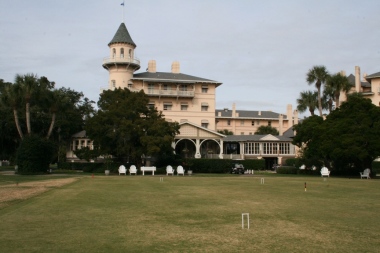During its heyday in the late 1800s and early 1900s, the membership of the fabled, ultra-exclusive Jekyll Island Club on Jekyll Island, Ga., comprised one-sixth of the entire world’s wealth. The roster of members included such titans of American industry and finance as John D. Rockefeller, J.P. Morgan, Cornelius Vanderbilt and Joseph Pulitzer.
These were not only the “one-percenters” of their day, they were more accurately called the one percent of the one percent.
The billionaires in the Jekyll Island Club chose the island for their getaways specifically because of its tranquility, and especially its remoteness from prying eyes and ears who might divulge some of the literally world-shaping decisions being made there, such as the creation of the Federal Reserve Bank in 1913 (which as its detractors like to point out, is neither federal nor a reserve, but a wholly privately-owned consortium — as indeed was the Jekyll Island Club itself).
Another event of enormous significance happened on Jekyll Island on this day in 1915, when the world’s first trans-continental phone call — actually a four-way conference call of sorts — partially emanated from the Club.
The story goes like this: The historic call had been intentionally planned to inaugurate the San Francisco World’s Fair. But Club member Theodore N. Vail, the first president of the American Telephone & Telegraph Company (AT&T) and proprietor of that historic phone line itself, was stuck at the Jekyll Island Club recuperating from a leg injury.
The stretch of the AT&T phone line between New York and San Francisco he was about to use passed through through 13 states. Though comprising only four copper wires, about 130,000 poles were needed to prop them up on their journey overland. On Jan. 25, 1915, about 1,500 AT&T employees were positioned across the length of the east/west line as well as between Jekyll and New York, prepared to address any issues with the call.
Alexander Graham Bell — yes, that Alexander Graham Bell, inventor of the telephone — started the event around four in the afternoon by speaking from New York to his assistant, Thomas Watson, who was positioned in San Francisco. Vail and J.P. Morgan, Jr. listened to the conversation in a parlor in the Jekyll Island clubhouse.
And so began the four-way call between Jekyll Island, New York City, San Francisco, and President Woodrow Wilson in Washington DC.
A huge media event for the time, the call included speeches by officials and a chat about the weather in Georgia between Vail and another person.
While waiting for President Wilson to be patched into the call, Bell and Watson were cajoled into recreating their famous first words over the first phone call, consisting of Bell saying, “Mr. Watson, come here please, I want you.”
Except in this reenactment, Watson responded to laughter that it would take at least a week for him to get to New York.
At that point Wilson’s voice chimed in to join the congratulations. He was eventually patched through to Jekyll Island, saying: “Hello, Mr. Vail.” To which Vail replied, “Who is this?”
“This is the President,” said Wilson. “I am glad to hear your voice. I have just been speaking across the continent this afternoon.”
The apparently quite laconic — or possibly just nervous — Vail said, “Oh, yes.”
“Before I give up the telephone,” continued Wilson, “I wanted to extend my congratulations to you on the consummation of this remarkable work.”
When Wilson closed by wishing Vail a speedy recovery from his injury, Vail gave what today would be a fairly politically incorrect reply from a major CEO:
“I am getting along very nicely. I am sort of a cripple, that is all.”
Even today, Jekyll Island is pretty sleepy. It’s no longer owned by those wealthy few, but by the people of the state of Georgia. Indeed, an act of the state legislature specifically reserves Jekyll as a recreation spot that must be accessible to “all the people” of Georgia.
Though every vehicle must pay a $5 parking fee to get onto the island, its amenities, including the formerly exclusive haunts of the ultra-rich, are accessible to the general public at reasonable cost. You can even stay in the Jekyll Island Club itself, now a four-star hotel (at three-star prices) and a National Historic Landmark.
As I write in Moon Charleston & Savannah, which includes a chapter on the Golden Isles of Georgia, the north end of Jekyll features most of its noteworthy sights. “Driftwood Beach” on the northeastern end, its namesake wooden ornaments the byproduct of the steady erosion constantly shaping all of Georgia’s barrier islands, is a great place for a peaceful and/or romantic stroll on the sand.
The Horton House ruins are an excellent example of tabby construction, that building material combining oyster shells, lime, sand, and water. (Contrary to old-school opinion, the Spanish didn’t build any tabby construction on the Georgia coast. The technique was used by later British settlers.)
And of course you can still visit the excellently preserved Jekyll Island Club itself, complete with croquet green.
The grounds of the Club are themselves a great place to meander; here’s a beautiful, ancient Live Oak.
Jekyll Island was known to the Spanish as Isla De Ballenas, island of the whales, a reference to the right whale breeding ground just off its coast. For whatever reason the Spanish never built a mission on Jekyll — possibly because adjacent St. Simons Island featured a sizeable mission already.
In any case, today Jekyll Island is still redolent with history, from the oyster shells in its tabby ruins, themselves taken from ancient Native American shell middens, to the old Club itself.




